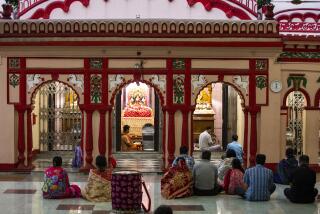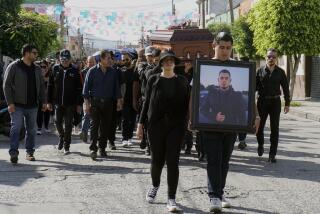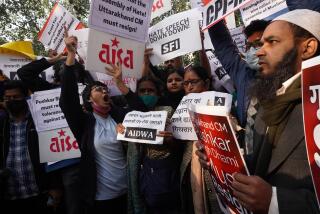Death Toll in India’s Sectarian Riots Reaches 485
- Share via
SARDARPUR, India — Poor Muslim farm workers hiding in a one-room house were a perfect target for Hindus bent on revenge.
No one is likely to raise a vigilante mob because of the deaths of 28 landless laborers and their children, who were burned to death around midnight Friday as they cowered in the dark. And survivors from a total of about 20 burned houses have fled this farming village of roughly 4,000 residents. No one expects them to dare come back.
By this morning, the official death toll after four days of religious violence here in the western state of Gujarat was 485, including 58 people who died Wednesday when a Muslim mob attacked a train carrying Hindu nationalists. That attack, near the town of Godhra, sparked the unrest that police and soldiers claimed Saturday to be bringing under control with curfews and a policy of shooting looters, arsonists and other troublemakers on sight.
Police said they had killed 73 people since Wednesday. The remaining victims died in communal violence, Gujarat’s state government said. But authorities had said the death toll would mount because they were finding more bodies and attacks were continuing in rural areas.
Indian Prime Minister Atal Behari Vajpayee went on national television Saturday to call for calm, as thousands of police and army troops patrolled cities and towns in Gujarat.
“Whatever the provocation, people should maintain peace and exercise restraint,” Vajpayee said. “The burning alive of people, including women and children, from Godhra to Ahmadabad and other places, is a blot on the country’s face.”
Ahmadabad, Gujarat’s largest city, and the rest of the state were reported mostly quiet Saturday, but in the Panchmahal district, attackers set a vehicle on fire, killing nine people.
Meanwhile, vigilante groups, both Hindu and Muslim, continued to roam the dirt tracks that connect Gujarat’s villages. Truck drivers said men at roadblocks made of burned-out vehicles, concrete drainage pipes or felled trees were checking driver’s licenses in search of people with what they considered the wrong religious beliefs.
At one rural crossroad, about a dozen Hindu men and teenage boys checked the few cars still moving for Muslims. One of the men was armed with a handmade sickle of heavy steel, ground to a sharp edge.
The bloodletting in Sardarpur, at least, was probably finished.
“In this village, it’s not going to happen again,” Subinspector Bhuralal Purohit of the Gujarat state police said through a translator. “There’s no [Muslim] community left to attack.”
But the Sardarpur massacre, whose smallest victim was about 5 years old, showed how in the Indian countryside, religion need not mark you for death. Often, the dispossessed live with the greatest risks because they are considered the most expendable.
The incinerated farm workers--police called them “outsiders” who had moved to Sardarpur from a nearby village--earned about $1 a day working in fields of wheat and tobacco.
The Hindu mob that attacked them sometime after 11:30 Friday night could have gone after more prosperous Muslims among about 350 descendants of ethnic Pushtun Afghans, called Pathan, who migrated to India generations ago. But police said those landowners were left alone.
All of Sardarpur’s surviving Muslims fled the village, but their Hindu neighbors will let only the Pathans return, Subinspector Galbahai Paramar said.
“These people who are laborers have gone and will never come back,” he said. “But the village people have no differences with these Pathans.”
Seven of the people killed in Sardarpur were children, whose mothers and fathers took shelter in the small light blue house at the end of a dirt lane because, Paramar said, they thought that it was the safest to place to hide.
Villagers told police that the trouble started when a mob of about 400 Hindus from a neighboring village came to Sardarpur and set fire to a stall that sold tobacco and betel nut for chewing.
A young Muslim man attacked one of the Hindus with a sword, Paramar said, the angry mob surged, and the frenzied burning and killing began. As of late Saturday, no one had been arrested in connection with the attacks and killings, Purohit said.
Paramar said he was leading a patrol of 11 policemen when he received a radio call between 12:30 a.m. and 1 a.m. telling him to respond to unrest in Sardarpur. It took his unit about an hour to reach the village because his officers had to remove several roadblocks to get through, he said.
The Muslim farm laborers’ enclave was ablaze when police arrived, the officer said, and he had to douse fires with a small bucket of water as he made his way along the dirt lane. Paramar learned that there were people in the blue house from a survivor living next door.
Thick smoke was pouring from the building’s front door, and when police finished dragging out the partially burned corpses, they counted seven children, 14 women and seven men.
Police said they thought that the Hindu mob came from the nearby village of Jantral, which lost two people in Wednesday’s train attack. But residents of Jantral and several other villages around Sardarpur denied that any of the train victims or Sardarpur’s attackers came from their communities.
Patel Babulal Barshottam, a local leader of the right-wing party Vishwa Hindu Parishad and a survivor of the train fire, condemned the Sardarpur killings but said they were understandable after what he called the premeditated murder at Godhra.
“The fires which are burning now are flames of religious war,” said Barshottam, 49, a farmer and businessman in the village of Kamalpur, about nine miles from Sardarpur.
Barshottam said a mob of about 1,000 Muslims forced the express train to stop about half a mile past the Godhra station about 6:30 a.m. Wednesday. When the crowd attacked with stones, Hindu passengers locked the doors, and then the train was firebombed, he said.
Mangu Ben Patel, 55, and her niece Lalita Ben Patel, 38, burned to death on the train, and relatives could identify their bodies only by the women’s jewelry.
They lived in Jaydevpura, a Hindu farming village of about 1,000 people next to a few state-owned oil wells, about 25 miles west of Ahmadabad. Lalita taught elementary school in the mainly Muslim village of Dudhai, said her cousin Hashmuk Patel, 41.
As Patel and other relatives mourned the women Saturday, they also worried that more attacks were coming. But the unrest seemed likely to end after a few more days, Patel said. Violent spasms in the age-old conflict between Hindus and Muslims always subside, he said.
Still, even visions of peace are clouded by prejudice here.
“Hindus forget easily. That’s why the riots will come to an end,” Patel said. “But Muslims do not forget easily. That’s why they are still going on.”
More to Read
Sign up for Essential California
The most important California stories and recommendations in your inbox every morning.
You may occasionally receive promotional content from the Los Angeles Times.













